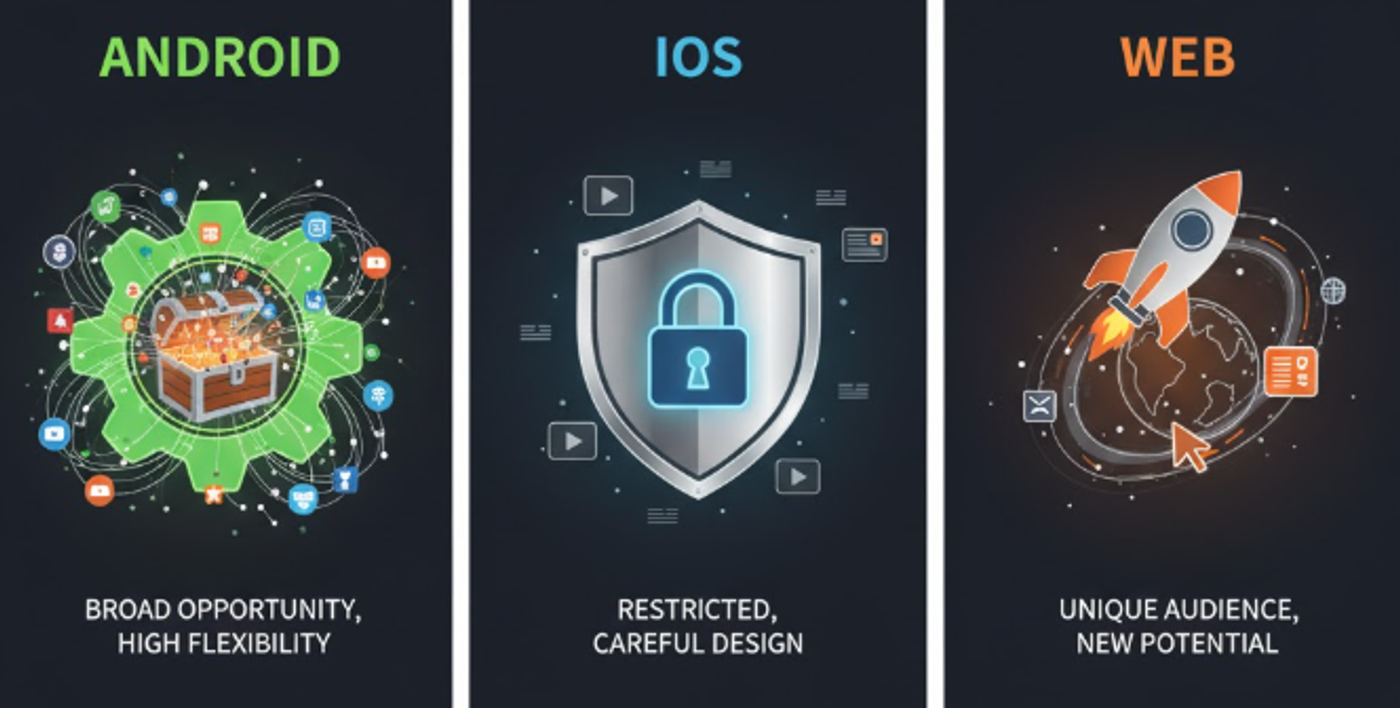“Cross-Platform Rewards: How Web, Android & iOS Offerwalls Differ”

Ajeet Thapa

Introduction
Offerwalls have become one of the most effective ways to convert user attention into revenue while keeping users engaged. The concept is straightforward: users complete tasks—watching videos, installing apps, or filling out surveys—and receive rewards in return. Yet, the experience is far from uniform. Each platform—Web, Android, and iOS—presents unique environments, technical considerations, and user behaviors that shape how offerwalls function and how users interact with them. These differences make understanding cross-platform dynamics essential for creating a seamless and effective rewards system.
How the Platforms Differ?
Android:
Android is the playground for flexible offerwalls. Here, publishers can tap into a wide variety of tasks—from app installs to trials and engagement actions. With Android SDKs, integrating offerwalls and handling rewards is seamless, which often results in higher fill rates and better eCPMs. For example, GameBiz Consulting highlights that Android offerwalls can unlock broad monetisation opportunities due to advertiser demand.
iOS:
iOS is more restrictive due to Apple’s policies on incentivised installs and actions. Publishers must focus on compliant offer types like watching videos or completing surveys, which can limit offer variety and sometimes reduce fill rates. Careful reward structuring and clear UX are essential here. You can see Apple-compliant strategies discussed in GameBiz Consulting’s guide.
Web:
Web offerwalls differ fundamentally in user context. They are ideal for desktop or mobile web users who aren’t inside an app. Tasks like signing up for services, completing surveys, or subscribing to newsletters perform well in this environment. Web offerwalls need to be integrated seamlessly into the user journey to prevent drop-offs, as explained by Ayet Studios. Responsive design and cross-device tracking are critical for maintaining engagement.

3. Why These Differences Matter: Impact on Monetisation & UX
- Offer inventory & fill‑rate: Android > Web > iOS typically. Because many advertisers favour Android and web for broader targeting, while iOS has stricter rules.
- Reward value & behaviour: On web, users may expect smaller, quicker tasks; on mobile they may be more mobile‑game‑native: “watch video to get extra life”. The reward size, user motivation differ. Adapty
- Retention & user journey: A well‑placed offerwall on mobile—e.g., after level completion, or when resource runs out—can extend session and reduce churn. On web, the user may navigate away unless the offerwall is seamlessly integrated.
- Integration complexity & tracking: Mobile SDKs vs web scripts; OS policy compliance (iOS); tracking across devices (web). Errors in reward delivery damage trust, reduce participation.
- Cannibalisation risk: If offerwalls are too generous, they may reduce direct transactions (in‑app purchases) especially on mobile. Some developers worry about this more for mobile than web.
4. Best Practices by Platform
- Android:
- Leverage broad offer types (installs, trials, engagement).
- Segment users: non‑payers get more visible offerwall placement; payers get “premium offers” to upsell.
- Monitor exchange rate (how many in‑game coins = $1 revenue) so you don’t overspend. gamebizconsulting.com
- iOS:
- Focus on compliant offer types (videos, surveys, trials) rather than installs.
- Use clear UX: users know what they do, what they’ll get.
- A/B test placement and reward size—since offerwall supply may be lower.
- Web:
- Make the offerwall opt‑in and well‑integrated: e.g., “Earn points by doing this task” rather than a disruptive pop‑up. AppSamurai
- Use responsive design so it works on desktop and mobile web.
- Leverage high‑value web offers (subscriptions, sign‑ups) that work better on a browser.
- Ensure tracking and reward fulfilment across devices and sessions.

5. Strategic Outlook & Emerging Trends
- As regulation tightens (GDPR, platform policies), offerwalls must adapt with clear disclosure, consent flows and transparent reward logic. AppSamurai
- Cross‑platform sync: Users move between web and mobile; reward systems increasingly expect continuity (e.g., “earn via web now, spend in mobile app”). Platform‑agnostic design gives competitive edge.
- Non‑gaming apps: Offerwalls have matured beyond games. Web portals, subscription services, social apps are now leveraging them. mylead.global
- Fraud & quality: As offerwall usage rises, control over fraudulent users, invalid completions, SDK exploits becomes more critical—especially on mobile where install fraud is high.
- Rewarding “good behaviours”: Beyond installs/surveys, expect more “micro‑actions” (watching branded content, longer‑form engagement) especially on web where a user isn’t in a “game mode”.
5. Conclusion
In essence: an offerwall is one core concept, but the platform context colors everything — what kind of tasks show up, how users engage, what scale and yield you can expect, how you integrate, and how you optimise.
- On Android, broadest opportunity, high flexibility, strong volume.
- On iOS, more restrictive, needs careful design and reward strategy.
- On Web, different user behaviour, different offers, tremendous opportunity for publishers beyond mobile apps.
In building your cross‑platform offerwall strategy, treat each platform not as “just another channel” but as a distinct environment—with its own UX expectations, monetisation levers, metrics. Pair that understanding with continual optimisation (A/B testing, segmentation, reward calibration) and you’ll unlock the full promise of the offerwall model.